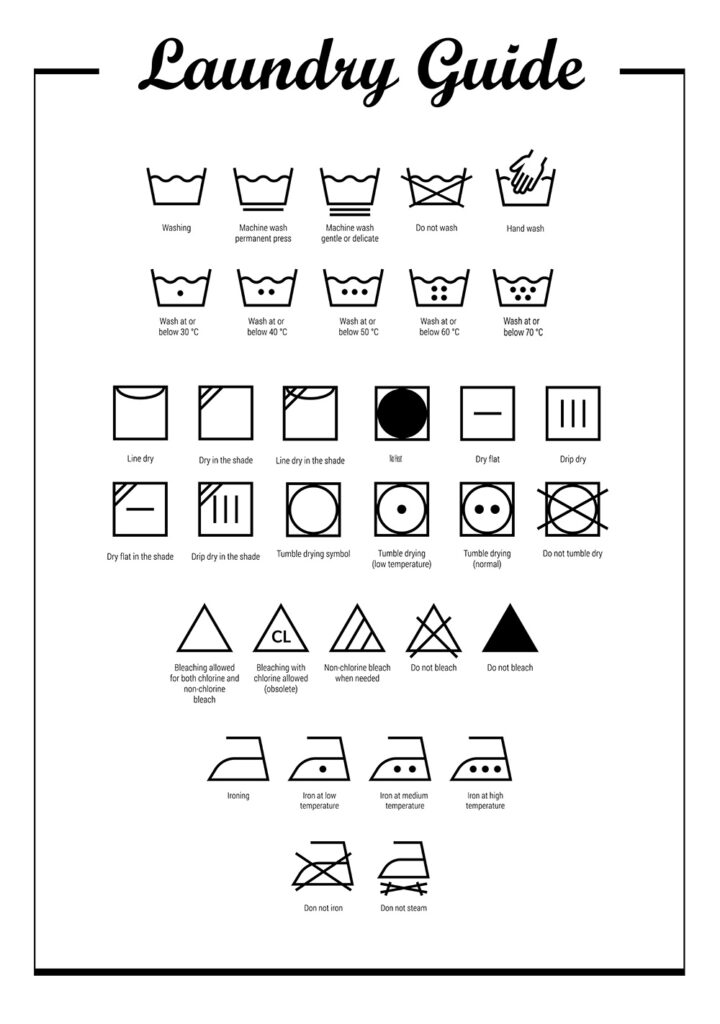
When you buy a new shirt, dress, or pair of jeans, you’re probably excited to wear it for the first time. But have you ever stopped to think about the small tags stitched inside your clothes? These tags carry essential information on how to properly care for your garments and extend their lifespan.
If you’ve ever been puzzled by the cryptic symbols on your clothing care labels, you’re not alone. Understanding them can make a big difference in how long your clothes last, how they feel, and how they look over time.
In this clothing care guide, we will break down the basics of clothing care labels, explain common fabric care symbols, and provide garment care tips to help you protect your favourite wardrobe pieces. This way, you can preserve the quality of your clothes while being environmentally conscious.
What Are Clothing Care Labels?
Clothing care labels are the tiny tags inside your garments that provide instructions on how to wash, dry, iron, and store your clothes. These instructions are meant to help you care for your clothing in a way that keeps it looking fresh and wearable for as long as possible.
Understanding washing instructions not only helps you avoid shrinking, fading, or damaging your clothes but also reduces energy and warm water use by washing at the right temperatures.
Key Symbols to Know on Clothing Care Labels
One of the biggest hurdles in deciphering clothing care labels is understanding the various symbols. Here’s a breakdown of some of the most common ones:

1. Washing Symbols
- Bucket with Water: This symbol indicates washing instructions. If the bucket has a number inside, that’s the maximum water temperature at which you should wash the garment (e.g., 30°C or 40°C).
- Hand in the Bucket: This means the garment should only be hand-washed. Avoid using a washing machine.
- Crossed-Out Bucket: This symbol tells you the garment should not be washed at all. Typically, these items need a dry cleaner.
2. Drying Symbols
- Square with a Circle Inside: This symbol indicates that the garment can be tumble dried. Dots inside the circle denote the temperature: one dot for low heat, two dots for medium heat, and three dots for high heat.
- Square with a Horizontal Line: This symbol means you should lay the garment flat to dry. This is common for fabrics like wool or cashmere to prevent stretching.
- Square with a Vertical Line: Line drying is recommended, either outside on a clothesline or indoors on a drying rack.
- Crossed-Out Square with a Circle: Avoid tumble drying; this fabric is delicate and could be damaged by high heat.
3. Ironing Symbols
- Iron with Dots: The number of dots inside the iron symbol corresponds to the temperature setting on your iron: one dot for low heat (synthetics like polyester), two dots for medium heat (silks and wool), and three dots for high heat (cotton and linen).
- Crossed-Out Iron: No ironing is required, or the fabric is too delicate to be ironed and may need steaming instead.
4. Bleaching Symbols
- Triangle: This symbol means the garment can be bleached using any kind of bleach.
- Triangle with Lines: Non-chlorine bleach only. This symbol often appears on colored fabrics to prevent fading.
- Crossed-Out Triangle: No bleach should be used, not even non-chlorine varieties.
5. Dry Cleaning Symbols
- Circle: Indicates that dry cleaning is allowed. The letters inside the circle (like “P” or “F”) provide information for professional cleaners regarding the type of solvent to use.
- Crossed-Out Circle: Do not dry clean.

How to Apply These Symbols in Everyday Garment Care
Once you understand what the symbols mean, it’s easier to apply them to your daily laundry routine. Here are some garment care tips to keep in mind:
1. Sorting Your Laundry
Before washing, sort clothes not only by color but also by fabric type. Washing delicate fabrics like silk or wool with heavy items like jeans can damage them. Look at the care labels to see if any items need to be washed separately or by hand.
2. Washing at the Right Temperature
As a rule of thumb, washing clothes in cold water is often better for the environment and helps preserve fabrics. Hot water can shrink or fade certain materials, especially cotton. Pay attention to the recommended washing temperature on the label. Delicate items typically need cooler water.
3. Using the Right Detergent
If the care label specifies “non-chlorine bleach only,” make sure you’re using the correct detergent. For wool, silk, and other natural fibers, opt for a gentle, pH-neutral detergent. Always check whether fabric softeners are recommended, as some materials, like spandex, degrade faster when exposed to softeners.
4. Avoid Overloading the Washing Machine
Even if all your clothes can be machine-washed, overloading the drum can lead to less effective cleaning, more wrinkling, and even damage. Clothes need space to move around freely during the wash.
5. Drying with Care
Air-drying is gentler on fabrics and helps them last longer. Even if tumble drying is allowed, consider line drying for more delicate pieces. Be cautious of wool garments that may lose shape when hung; laying them flat to dry is usually the best option.
6. Ironing and Steaming
Always check the care label before ironing. For delicate fabrics that can’t withstand high heat, use a low setting or opt for a clothes steamer instead. Steaming is often a gentler way to remove wrinkles from delicate fabrics like silk and polyester.
Why Following Care Labels Matters
Taking the time to follow the instructions on clothing care labels has several benefits:
- Longer Lifespan of Your Clothes: When you wash, dry, and store clothes as recommended, they’re less likely to wear out quickly. This saves you money in the long run and reduces waste.
- Better Fabric Quality: Proper care preserves the texture, color, and fit of garments. Whether it’s preventing shrinkage, color fading, or material pilling, following the label ensures your clothes remain in good condition.
- Environmental Impact: By extending the life of your clothes, you’re contributing to a more sustainable fashion industry. Fewer clothes need to be replaced, which means less waste and fewer resources used in production.

Common Mistakes to Avoid
Here are a few mistakes people often make with clothing care and how to avoid them:
- Ignoring care tags: Skipping care instructions often leads to irreversible damage like shrinkage, stretching, or color bleeding.
- Using too much detergent: More detergent doesn’t necessarily mean cleaner clothes. It can leave a residue that’s hard to rinse out and cause fabrics to feel stiff or sticky.
- Over-drying clothes: Tumble drying on high heat can make fabrics brittle and prone to tears. Stick to the drying instructions to maintain the quality of your clothes.
Conclusion: A Simple Step Toward Better Garment Care
Decoding clothing care labels might seem like a small step, but it can significantly extend the life of your garments and make your wardrobe more sustainable. Understanding and following the symbols and washing instructions will help you keep your clothes looking new for longer while minimizing their environmental footprint. Next time you do laundry, take a closer look at those care labels — you’ll be glad you did!





Leave a Reply